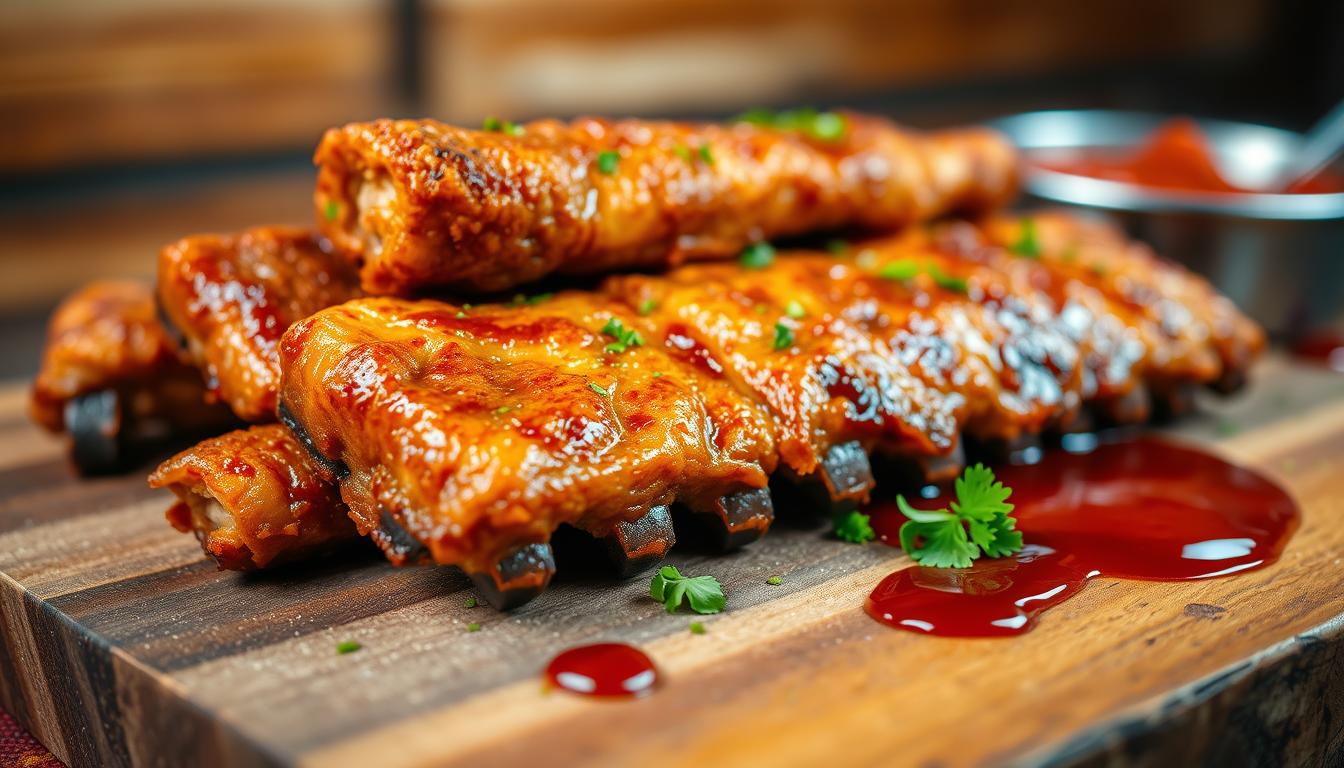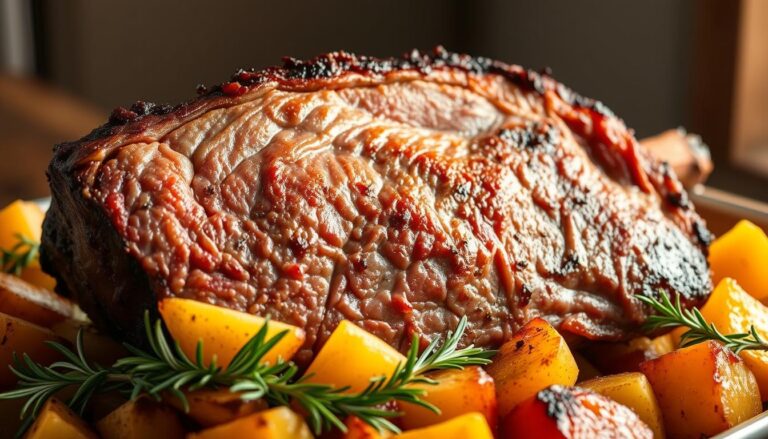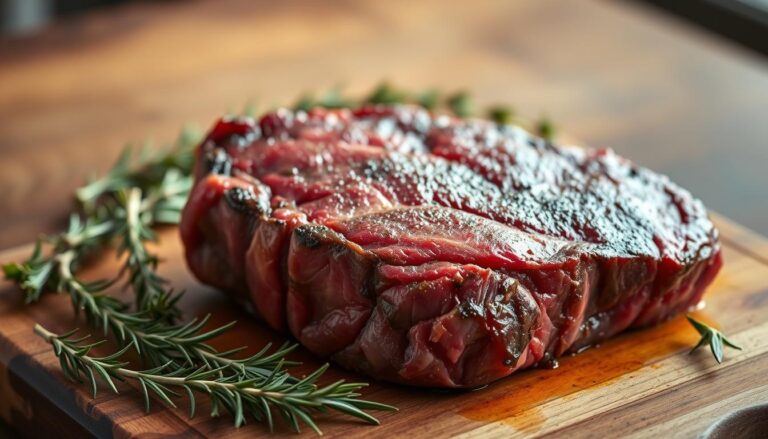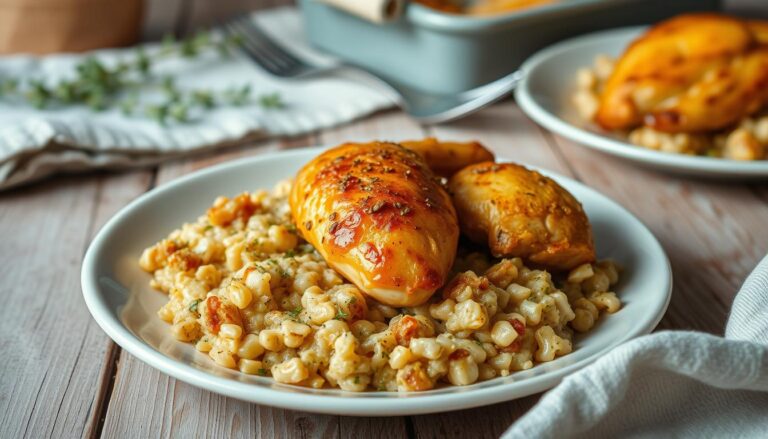Mouthwatering Fried Ribs Recipe: Crispy Perfection
fried ribs recipe
There’s nothing like the sound of a golden crust breaking to reveal tender meat. For years, the secret to the best fried ribs was kept by restaurants. But now, you can make this magic at home with our recipe.
Your kitchen will fill with the sizzle of hot oil and the smell of buttermilk and spices. These fried ribs are more than just a dish. They’re about enjoying that first bite where the crunch gives way to tender meat. They’re perfect for any occasion, from game day to family dinners, and they use ingredients you likely have on hand.
Table of Contents
Introduction to Fried Ribs
Crispy fried ribs have a golden, crunchy outside and juicy meat inside. This dish combines tradition with a delicious texture. It’s a favorite at parties.
What Are Fried Ribs?
Traditional fried ribs are made from pork or beef ribs. They are seasoned, coated in breading, and then fried until crispy. The main cuts include:
- Baby back ribs: tender and popular for their shape and flavor
- Spare ribs: meaty and budget-friendly
- St. Louis-cut ribs: trimmed to uniform size for even frying
Why Choose Fried Ribs Over Other Cooking Methods?
Frying offers three main advantages:
- Speed: You can get crispy fried ribs in minutes, unlike smoking which takes hours.
- Texture contrast: The breading creates a crackling crust while keeping the meat juicy.
- Consistency: Frying at 350°F ensures even cooking without drying the meat.
Whether you grill, smoke, or bake, frying’s quick process and crispy results are unbeatable. Your next gathering will love this crowd-pleasing dish.
Ingredients You’ll Need for Fried Ribs
Mastering homemade fried ribs starts with the right ingredients. You need the right cuts, seasonings, and coatings. This ensures your ribs are as delicious as possible. Let’s break down what you’ll need for every step of the process.
Essential Cuts of Ribs
Pick the right ribs for your dish. Common choices include:
- Pork baby back ribs (10–13 ribs per rack)
- St. Louis-style ribs (trimmed for even cooking)
- Spare ribs (meatier with more fat)
- Beef short ribs (for a rich alternative)
Seasoning and Marinade Options
Seasonings and marinades add flavor. Use these to enhance your ribs:
- Buttermilk marinade: Soaks ribs for at least 1 hour (or overnight) to tenderize
- Spice blends: Mix paprika, garlic powder, onion powder, salt, and pepper
- Mustard base: Dijon mustard acts as a sticky base for dry rubs
Recommended Breading Ingredients
Create a crispy crust with these key breading ingredients:
- All-purpose flour and cornstarch (1:1 ratio)
- Baking powder (1 tsp per cup of flour for lightness)
- Spices like black pepper and cajun seasoning (like Slap Ya Mama Cajun)
| Detail | Measurement |
|---|---|
| Flour & cornstarch mix | 1/2 cup each |
| Marinade time | 1 hour–overnight |
| Oil needed | 4 cups peanut oil (350°F) |
Pro tip: Use buttermilk and a 1:1 flour mix for crispy results. This setup ensures your ribs stay juicy inside while achieving that golden, crunchy exterior of delicious fried ribs.
| Recipe Stats | Details |
|---|---|
| Prep Time | 15 minutes |
| Cook Time | 2h 10m |
| Servings | 4 people |
| Calories per serving | 550 kcal |
Preparing the Ribs for Frying
Mastering the easy fried ribs recipe begins with proper preparation. Follow these steps to ensure your ribs are ready for the best crispy results in your top fried ribs recipe.
Trimming and Cleaning the Ribs
Begin by removing the membrane from the rib bones. Use the edge of a spoon to lift the membrane, gripping it with a paper towel for better traction. Trim excess fat to avoid greasy results. Rinse ribs under cold water, pat dry with towels, and cut into portions before marinating.
Marinating the Ribs: Best Practices
For tenderness, marinate ribs in buttermilk for at least 1 hour—overnight is ideal. Mix 2 cups buttermilk with 2 tbsp apple cider vinegar and 1 tsp garlic powder in a resealable bag. Acid in the buttermilk breaks down muscle fibers, enhancing tenderness. Store in the fridge, turning occasionally.
Drying Ribs Before Breading
Pat ribs dry with paper towels after marinating. Let them air-dry uncovered for 30 minutes at room temperature. Moisture causes soggy coatings and oil splatter, so this step is critical. Follow these steps:
- Pat dry with clean towels
- Place on a wire rack over a baking sheet
- Air-dry for 30 minutes
Pro tip: Bring ribs to room temperature before frying to ensure even cooking. Skipping drying leads to uneven browning in the top fried ribs recipe.
The Breading Process Explained
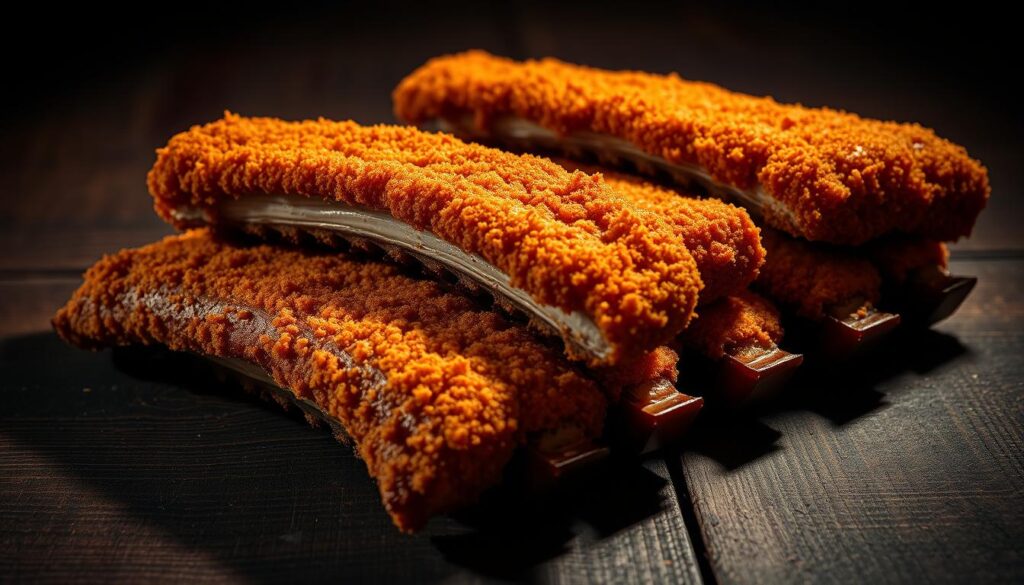
Getting the breading right is crucial for delicious flavorful fried ribs recipe. We’ll go over the steps to get your crispy fried ribs with a golden, crunchy crust every time.
Using Dry Breading vs. Wet Breading
- Dry breading: Toss ribs in ½ cup seasoned flour alone for a simpler, lighter coating.
- Wet breading: Dip ribs first in buttermilk or egg wash before coating in flour for deeper flavor and crunch.
Tips for Perfectly Coated Ribs
Here’s how to get flawless coverage:
- Use the double-dip technique: Dredge ribs in flour, dip in buttermilk, then coat again in flour. Press firmly to seal the coating.
- Rest ribs 15–30 minutes after breading to set the crust.
- Heat ¼ cup oil to 330°F before frying for even cooking.
Common Breading Mistakes to Avoid
Avoid these common errors:
- Skipping drying ribs before breading = loose coating.
- Crowding the pan = greasy, uneven results.
- Overcrowding ingredients = undercooked centers and soggy crust.
Pro tip: For extra crunch, use panko breadcrumbs instead of regular flour. Adjust seasoning to match your preferred flavorful fried ribs recipe. Always test oil temperature with a thermometer. Now your ribs are ready for the pan—next, we’ll cover the perfect frying technique.
Choosing the Right Cooking Oil
Choosing the right oil is key to making the best fried ribs. The oil you pick impacts taste, texture, and safety. Look for oils with high smoke points for crispy results without burning.
Chefs recommend avocado oil for its clean taste and stability at high heats.
Best Oils for Frying
Choose oils with smoke points over 400°F (204°C). Here are some top picks:
- Avocado oil (520°F/271°C): It has a neutral taste and is good for your heart. Try Chosen Foods avocado oil for crispy ribs without strong flavors.
- Peanut oil (450°F/232°C): A Southern favorite, it adds a subtle nutty taste.
- Canola oil (400°F/204°C): It’s affordable and versatile, perfect for those on a budget.
- Grapeseed oil (440°F/227°C): It has a light texture and is stable for golden coatings.
Understanding Smoke Points
An oil’s smoke point is when it starts to burn, releasing harmful stuff. For frying ribs, pick oils with smoke points over 400°F to avoid bitterness and ensure safety. For example:
- Extra-virgin olive oil (375°F/190°C) is too low for deep frying but good for pan-searing.
- Coconut oil (350°F/177°C) is not good for frying ribs because of its low smoke point.
Use high-quality oils like avocado or peanut for ribs that are tender inside and crispy outside. The right oil choice makes your homemade fried ribs taste great and stay safe every time.
Frying Techniques for Optimal Crispiness
Discover the secret to the perfect crunch with these frying techniques. Whether you’re making delicious fried ribs or traditional fried ribs, these steps will help you get a golden-brown exterior every time.

| Method | Equipment | Oil Depth | Best For | Key Tips |
|---|---|---|---|---|
| Deep Frying | Deep fryer or stockpot | Covers ribs entirely | Large batches | Use a thermometer. Cook in batches to avoid temp drops. |
| Shallow Frying | Cast iron skillet | 1-2 inches of oil | Small batches at home | Flip ribs often. Monitor oil levels closely. |
Deep Frying vs. Shallow Frying
Deep frying fully submerges ribs, ensuring even heat. For traditional fried ribs, a cast-iron skillet is great for shallow frying at home. Always use a thermometer to track oil temp.
Right Temperature and Timing
- Heat oil to 350°F (175°C). Avoid overheating—smoke points ruin flavor.
- Cook 5–7 minutes per batch. Turn ribs occasionally for even browning.
- For extra crunch, try a two-stage fry: start at 120°C, then boost to 190°C (375°F) for 1–2 minutes.
Check doneness when ribs turn golden and the oil bubbles around them. Let them drain on a rack—this keeps them crispier than paper towels. Never overcrowd the pan; this lowers oil temp and creates soggy coatings.
Making a Delicious Sauce to Accompany Fried Ribs
A flavorful fried ribs recipe gets even better with the right sauce. Sauces add contrast to the crispy texture. They balance out the flavors with tangy, sweet, or spicy notes. You can pick from classic styles or make your own in under 15 minutes.
Popular BBQ Sauces for Fried Ribs
There are many regional BBQ sauce styles to try. Kansas City offers sweet tomato-based sauces, while Carolina has vinegary ones. Memphis is known for tangy mixes. You can also try spicy aioli, lemon-garlic butter, or sweet chili for dipping.
Match bold sauces with mild ribs or use mellow dips with bold meats. This way, you can find the perfect combination for your taste.
DIY Sauce Recipe Ideas
| Recipe | Ingredients | Instructions |
|---|---|---|
| Classic BBQ Sauce | 1 cup ketchup, ¼ cup white vinegar, ¼ cup brown sugar, 2 tbsp paprika, 1 tbsp olive oil, 1 tsp chili powder, 1 tsp garlic powder | Whisk ingredients. Simmer 10 mins. Store in fridge up to 7 days. |
| Spicy Honey Glaze | ¼ cup honey, 2 tbsp soy sauce, 1 tbsp sriracha, 1 tbsp butter | Melt butter, mix all. Brush ribs in last 5 mins of frying for caramelization. |
| Lemon-Garlic Aioli | ½ cup mayo, 2 tbsp lemon juice, 2 minced garlic cloves, 1 tsp Dijon mustard, salt | Whisk ingredients. Use as dip for ribs or fries. |
Tips for Glazing and Serving
- Apply sauces post-cooking to avoid burning sugars. Brush glazes at the end of frying.
- Customize heat levels with cayenne or chili powder. Adjust sugar for balance.
- Pair with sides like coleslaw or cornbread. Store unused sauce refrigerated for 7 days.
Pairing sauces with fried ribs recipe makes every bite better. Try different blends to find what you like. Adjust sweetness or heat to your taste. Serve extras with veggies or sliders for a complete meal.
Serving Suggestions for Fried Ribs
Match your best fried ribs with sides that offer a mix of flavors and textures. Southern favorites like creamy coleslaw, buttery cornbread, or tangy collard greens are great choices. They balance the richness of the ribs and keep the meal exciting.
For a fresh twist, consider roasted rainbow carrots with thyme or a honey lime grilled corn salad. These options add color and a burst of flavor to your dish.
Creative Side Dishes to Pair
- Coleslaw: Chill it for at least two hours to cut through the ribs’ richness. Choose vinegar-based coleslaws if you prefer something lighter than mayo.
- Roasted Vegetables: Rainbow carrots with crushed red pepper or asparagus with balsamic glaze bring color and nutrients to your plate.
- Baked Beans: A 35-minute oven bake with pork adds a smoky flavor that pairs well with top fried ribs recipe creations.
- Quick Pickles: Dill pickles or pickled okra offer a tangy contrast. Prepare them ahead for a 24-hour flavor enhancement.
Presentation Ideas for Gatherings
Make your best fried ribs the highlight of any gathering:
- Place ribs on a wooden board with cornbread wedges and a drizzle of BBQ sauce.
- Serve ribs family-style with sides in colorful bowls. Use bowls like cobalt blue or terracotta for a pop of color.
- Top individual plates with fresh herbs like parsley or microgreens for a vibrant touch.
“Presentation transforms a meal into an experience—simple garnishes like lemon wedges or edible flowers can elevate even the simplest rib platter.”
Pair quick sides like 20-minute potato salad or 10-minute cornbread to save time. Let coleslaw chill and kale slaw marinate up to three days ahead for the best flavor. Your top fried ribs recipe deserves sides that are just as impressive.
Common Mistakes to Avoid
Mastering the easy fried ribs recipe means knowing what to avoid. Even with the best traditional fried ribs techniques, common pitfalls can ruin your dish. Here’s how to spot and fix issues before they happen.
Overcooked Ribs: Signs and Solutions
- Signs: Ribs feel tough, dry, or stringy when pulled apart.
- Solutions: Use a meat thermometer. Remove ribs when they reach 195°F internally. Overcooking breaks down collagen into gelatin, but exceeding 205°F makes meat chewy.
Breading Issues: How to Fix Them
Fix these coating problems to ensure crispiness:
- Coating falling off: Dry ribs thoroughly before breading. Moisture prevents adhesion. Pat with paper towels.
- Soggy coating: Heat oil to 350–375°F. Cold oil absorbs more grease, creating a soggy crust.
- Uneven breading: Shake excess flour before frying. Overly thick coatings flake off mid-cook.
Remember: Overcrowding the pan lowers oil temperature. Fry in small batches to maintain heat stability. These fixes turn mistakes into a traditional fried ribs success story!
Conclusion
Getting crispy fried ribs right takes focus on every step, from marinating to frying. Each method ensures the ribs get a golden, crunchy outside while staying soft inside. It’s more than just a meal; it’s a chance to play with flavors and cooking techniques.
Key Steps for Crispy Fried Ribs
Begin by marinating the ribs in a mix of soy sauce, spices, and breading. Dredging them in seasoned flour or cornstarch keeps moisture in. Frying at 375°F (190°C) gives that perfect crunch. Serve with tangy or sweet sauces for a nice balance.
Customize Your Crispy Fried Ribs
Try adding bold flavors like star anise or sesame seeds, or use a soy-ginger marinade for an Asian flair. Serve with jasmine rice or pineapple for texture. You can also change up the breading to panko or crushed nuts for more crunch. Whether you like a quick stir-fry or a slow-cooked version, you can make it your own.

